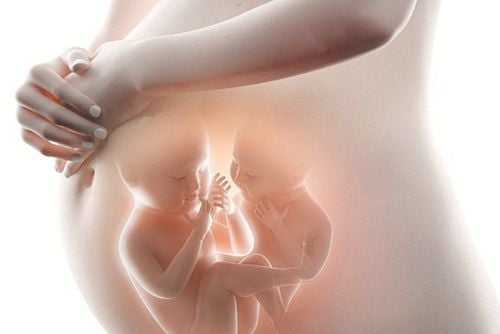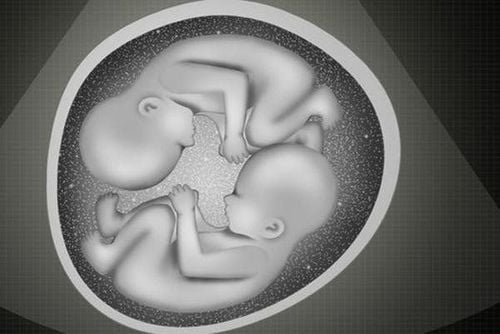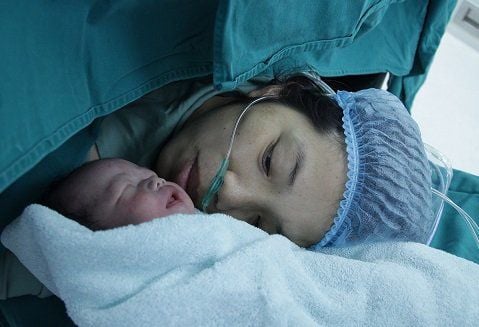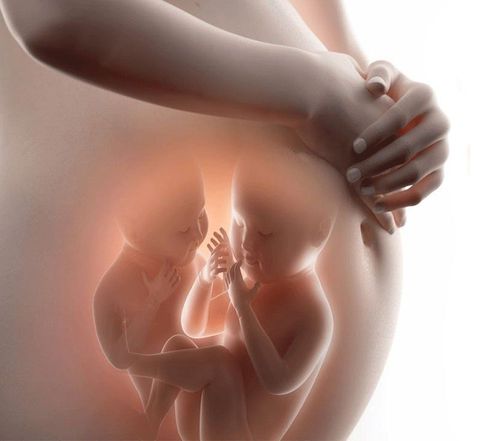This is an automatically translated article.
The article was professionally consulted by Specialist Doctor I Truong Nghia Binh - Obstetrician-Gynecologist - Department of Obstetrics and Gynecology - Vinmec Da Nang International General Hospital.
Pregnancy is already an arduous journey, but when a mother is carrying two or more babies, the hardship increases. The mother needs to keep an optimistic spirit and good health to welcome the baby.
1. Multiple pregnancy
Multiple pregnancy is when two or more babies grow in the mother's womb at the same time. Sometimes the babies will look exactly alike – identical twins, but other times they will just look like normal siblings – fraternal twins. This happens in different ways2. Multiple pregnancy with the same egg
Identical multiple pregnancy: A phenomenon in which an egg, after being fertilized, splits in half during the zygote stage and develops into 2 or more embryos. Two or more individuals when developed will be similar in appearance, genes and antigens.Single-egg multiples are always of the same sex, are genetically identical, and have very similar biological characteristics.
3. Multiple fraternal twins
Fraternal twins, also known as non-identical twins, are made up of two completely separate eggs and two sperm. Unlike identical twins, the genetic makeup of fraternal multiples is different. Often, fraternal multiples are more common than fraternal multiples.4. Multiple pregnancy with same mother, different father
If a woman has two or more eggs, during the conception window, it is entirely possible that each egg was fertilized at different times, even from different men. So it's possible that multiple babies are born to different fathers.5. Close connection

6. Birth method for mothers carrying multiples?
Cesarean section (cesarean section) means that the baby will be removed from the mother's womb through an incision, this method is usually done to ensure the health of the mother and the baby. Mothers with twins are more likely to have a cesarean section, and most mothers with triplets or more have this.7. Causes of multiple pregnancy
7.1 Fertility drugs Why are some women more likely to have multiples? It is due to a number of factors. For example, if a woman is unable to get pregnant, her doctor may recommend that she take medicine to help her ovaries produce more eggs. With more eggs, the chances of getting pregnant are also increased, and the chances of a woman having multiple fraternal twins also increase.7.2 In vitro fertilization When a doctor collects eggs from a woman's ovaries, usually after she has just taken fertility drugs. The resulting egg is fertilized with sperm outside the uterus and re-implanted into the uterus.
The procedure is both difficult and unpredictable, so usually two or more fetuses enter the mother's uterus to increase the likelihood that at least one fetus will grow and develop. Sometimes, both or more babies develop, and the parents will have multiple fraternal twins.
7.3 Mother's age and race More than 35 percent of women in the United States have children in their thirties, thanks in part to assisted reproductive methods. Even without a doctor's help, women in their thirties can still have two or more eggs at a time, perhaps because their bodies produce more ovarian-stimulating hormone to increase their ability to function. ovarian movement. African-American women are most likely to have twins, while Asian-American women are least likely.
7.3 Mother's height Mothers with multiples are on average about 2.5 cm taller than the rest of the mothers. A hormone that is more abundant in tall women – IGF – insulin-like growth factor – may be to blame. It is conjectured that IGF causes the ovaries to release more eggs, but more research is needed to confirm this hypothesis.
7.4 Milk One study found that women who drank more milk or ate more dairy products were pregnant with twins. Some scientists claim that milk teeth and dairy products cause the body to produce more of the hormone IGF, which leads to more eggs being released during a menstrual cycle.
7.5 Other causes of multiple pregnancy If the mother's grandmother or sisters have had fraternal twins, the mother's chances of having twins are also doubled. Mothers with a higher body mass index (BMI) are also more likely to have twins. BMI is a measure of the amount of body fat, so a BMI higher than normal is generally not good for the mother at all.

8. When should a mother see a doctor?
Being pregnant with multiples means that the mother has to bear the risk of complications and gives birth earlier than a single pregnancy, so the doctor always monitors the mother's health and visits the mother regularly. Doctors will closely monitor the growth and development of the babies, check the mother's condition and watch out for signs of early labor.8.1 See the doctor more often Mom will have to go to the doctor many times to check the growth and development of the babies, monitor the mother's health and signs of early labor. Especially later on, as the pregnancy progresses, the mother will have to have more ultrasounds or other tests,
8.2 More weight gain Mothers gaining the right amount of weight can support the health of the babies. For twins, the recommended weight is about 17-25 kg, for mothers with a normal weight before pregnancy, usually the mother has to take in an extra 600 calories per day. Please consult an expert for the right advice.
8.3 Early delivery If labor doesn't start on its own, doctors can induce labor or perform a cesarean section at a precise time in the third trimester to minimize the risk of complications during the first trimester. Tuesday.
9. Complications mothers need to consider
Every day, many babies with multiples are born healthy. However, mothers need to beware of the following possible complications:9.1 Preeclampsia This complication causes high blood pressure and other problems. Preeclampsia can occur in any pregnancy, but it is more common in multiple pregnancies. Elevated blood pressure is often the first sign, in addition to headaches, vision loss, nausea, and vomiting. This complication is dangerous for both mother and baby, but don't worry, there are medications available to lower blood pressure and treat other symptoms. Preeclampsia goes away on its own after the mother gives birth.
9.2 Premature birth If you are already showing signs of premature labor, you will be given steroid injections to speed up the growth of your baby's lungs. Even after receiving the injection, your baby is still at risk for complications such as difficulty breathing, indigestion, vision loss, and infection. Interventions to prolong pregnancy such as bed rest are not recommended because they have not been shown to reduce infant morbidity and mortality.
9.3 Gestational diabetes When you're pregnant with multiples, you're at increased risk of gestational diabetes. High blood sugar is bad for both mother and baby. See your endocrinologist or dietitian for help with blood sugar control during pregnancy

9.5 Caesarean section For twins, the mother is likely to have a normal delivery if the first baby is in the first position. If not, your doctor will recommend a cesarean section. In some cases, from complications from the first vaginal birth, the mother will have to have surgery to deliver the second baby. The more babies a mother has, the more likely she is to have a cesarean section.
9.6 Twin-to-twin transfusion For identical twins, having blood vessels in the common placenta puts them at risk of one receiving too much blood and the other very little. This is a serious complication for both babies, causing heart complications and requiring fetal intervention while the mother is pregnant.
The Maternity Package at Vinmec International General Hospital supports pregnant women from before, during and after giving birth. When registering for a package maternity program, pregnant women will be monitored and examined by qualified doctors. The mother will be followed up by obstetricians and gynecologists, and the staff will call regularly before the scheduled appointment, ultrasound and test.
Regular check-ups will help detect abnormalities of the fetus early, especially in the case of multiple pregnancies. Pregnant women will have periodic ultrasounds, 3D/4D ultrasounds to screen for fetal malformations at important weeks such as: Week 12, week 18, week 32... Depending on each maternity package, pregnant women can also do blood tests, urine tests, Double test, Triple test... support detecting abnormal signs.
Customers can directly go to Vinmec Health system nationwide to visit or contact the hotline here for support.
Specialist doctor I Truong Nghia Binh has over 13 years of experience in the field of Obstetrics and Gynecology, has high expertise and long experience in diagnosing and treating Obstetrics and Gynecology diseases such as: screening for diseases of mother and baby before birth chorionic villus biopsies, amniocentesis.. Ultrasound to screen for fetal malformations (3D, 4D ultrasound) Follow-up, birth control in cases of normal or difficult birth treatment of pre-eclampsia, placenta previa, pregnancy with complicated medical conditions... Cesarean section for 1st, 2nd, 3rd time caesarean section... Examination, treatment treatment of gynecological diseases. Examination and consultation of infertile couples
Please dial HOTLINE for more information or register for an appointment HERE. Download MyVinmec app to make appointments faster and to manage your bookings easily.
Articles source references: Webmd.com, Mayoclinic.org













